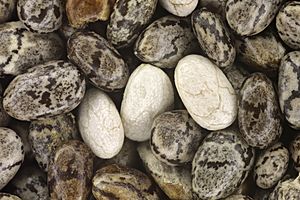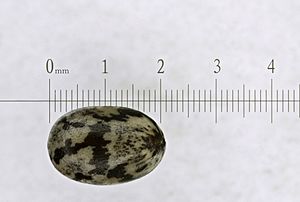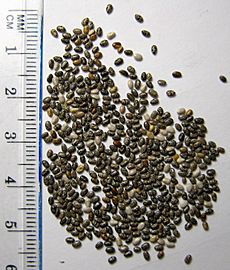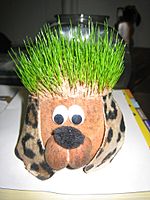Chia seed facts for kids
Chia seeds are tiny, edible seeds. They come from a flowering plant called Salvia hispanica. This plant is part of the mint family. It grows naturally in central and southern Mexico. Another type, Salvia columbariae, grows in the southwestern United States.
Chia seeds are small and oval-shaped. They are gray with black and white spots. Each seed is about 2 millimeters wide. These seeds love water! They can soak up to 12 times their weight in liquid. When they get wet, they form a jelly-like coating. This gives foods with chia a special gel texture.
People have grown chia seeds for a very long time. The Aztecs grew them widely before Europeans arrived. Chia seeds were a main food for many ancient cultures in Mesoamerica. Today, people still grow chia seeds in Mexico and Guatemala. They are also grown for sale in other parts of Central and South America.
Contents
What Are Chia Seeds Like?
Chia seeds are very small. They are flat and oval-shaped. They are usually mottled with brown, gray, black, and white colors. As you learned, they are hydrophilic. This means they love water! They can soak up to 12 times their weight in liquid. When soaked, they get a jelly-like coating. This gives them a unique gel texture.
The main plant for chia seeds is Salvia hispanica. Another plant called "golden chia" (Salvia columbariae) also has edible seeds.
Today, people grow and sell chia seeds in many countries. These include Mexico, Guatemala, Bolivia, Argentina, Ecuador, Nicaragua, and Australia. New types of chia plants have even been grown in Kentucky, USA. These types can grow well in colder places.
The amount of chia seeds a farm produces can change. It depends on the plant type and how it is grown. It also depends on the weather and location. For example, farms in Argentina and Colombia can produce different amounts of seeds.
History of Chia Seeds
Chia seeds have a long and interesting history. An old book from the 1500s, called the Codex Mendoza, shows this. It proves that the Aztecs grew chia seeds a lot. This was even before Europeans came to America. Some historians think chia was as important as corn for food.
The Aztec people often gave chia seeds as a yearly payment to their rulers. This happened in 21 of the 38 Aztec states. Chia seeds were a very important food for the Nahuatl (Aztec) people. Some old writings say chia was the third most important crop for the Aztecs. Only corn and beans were more important. Aztec priests were often paid with chia seeds.
Today, people still use chia seeds in many ways. In countries like Argentina, Bolivia, Guatemala, and Mexico, they make healthy drinks and foods. Chia is still grown in its original home in Mexico and Guatemala. It is also grown on a larger scale in other countries.
What's Inside Chia Seeds?
Chia seeds are packed with good stuff! Dried chia seeds have water, carbohydrates, protein, and fat.
A small amount of chia seeds (about 100 grams) is full of important things. They are a great source of B vitamins. These include thiamin and niacin. They also have good amounts of riboflavin and folate.
Chia seeds are also rich in many dietary minerals. These include calcium, iron, magnesium, manganese, phosphorus, and zinc. These are all important for your body.
The fatty acids in chia seed oil are mostly healthy unsaturated fats. These include linoleic acid and linolenic acid.
How People Use Chia Seeds
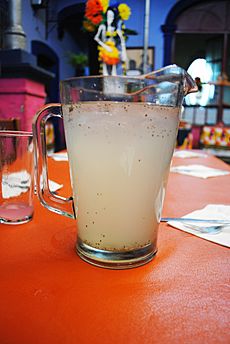
You can use chia seeds in many ways! You can sprinkle them whole or ground on top of other foods. They are great mixed into smoothies. You can add them to breakfast cereals, energy bars, granola bars, and yogurt. They can also be baked into tortillas and bread.
You can soak chia seeds in water and drink them directly. Or, mix them with juice to make a drink called chia fresca. You can also mix them with milk. People make chia seed pudding too. It is like tapioca pudding. You make it with milk, a sweetener, and whole chia seeds.
Ground chia seeds can also make a jelly-like substance. This gel can even replace eggs in cakes! It is a common choice for people who do not eat animal products.
In 2009, the European Union said chia seeds were a "novel food." This means they were new to Europe. They allowed chia seeds to be up to 5% of the total ingredients in bread.
Unlike flax seeds, you do not need to grind whole chia seeds. Their outer layer is soft and easy to digest. This helps your body use their nutrients better.
Chia Pet
Have you ever heard of a Chia Pet? Joe Pedott created these fun items in 1977. They became very popular in the 1980s. A Chia Pet is a clay figure. You spread a sticky paste of chia seeds on it. Then you water the figure. The seeds sprout and grow green "fur"!
Chia Pets are sold as fun novelty items or house plants. About 500,000 Chia Pets were sold in the U.S. in 2007.
Images for kids


